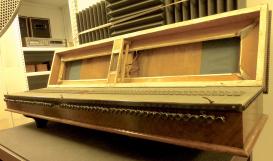In November 2018, it was declared that the kilogram, embodied by a platinum cylinder stored in Paris since 1889, would henceforth be defined by the Planck constant—a universal constant of nature relating the energy carried by a photon to its frequency. In the “weights and measures” of sound and music, the standard concert-pitch A, by which musicians and instrument-makers tune their instruments, has since 1939 been defined by the frequency of 440 Hertz, and like the old kilogram has traditionally been embodied by a metal object—the tuning fork—which is struck to reproduce its tone.
Scientific experiments with tuning forks helped to establish the foundations of modern acoustics. However, during the nineteenth century, tuning forks themselves were often calibrated using a microtonal harmonium-type instrument called the reed tonometer, examples of which were manufactured by Georg Appunn of Hanau. These were used by English acoustician Alexander Ellis to measure frequency and study the effects of temperature on vibrating reeds. In 1893, Max Planck employed a microtonal harmonium for experiments in musical temperament, alternating “just” intonation and “equal” tempered scales to study accommodation in hearing. Arguably, these investigations influenced Planck’s theoretical work involving radiation frequency and the proportionality constant that would ultimately bear his name.
This project, informed by the complex history of musical tuning, is carried out in collaboration with Fanny Gribenski of the “Epistemes of Modern Acoustics” research group. It will develop electroacoustic compositions that draw on my recordings of scientific instruments from the Acoustics Collection of the Science Museum, London, including two of Appunn’s tonometers and historic tuning forks by Scheibler and König.

